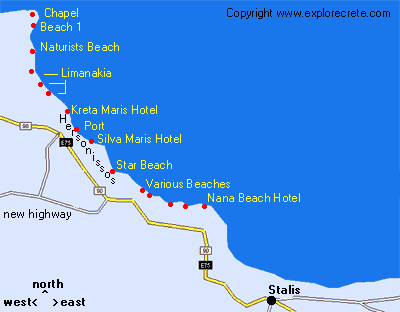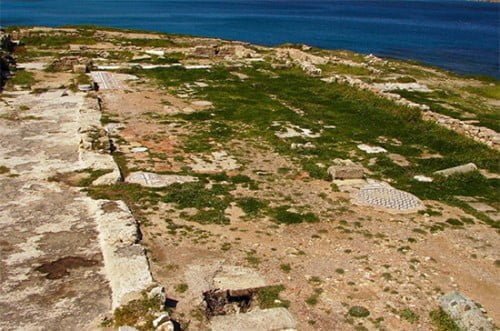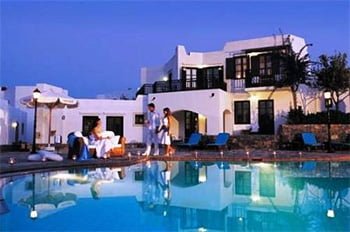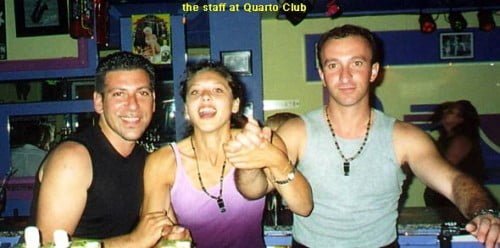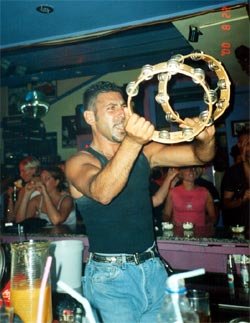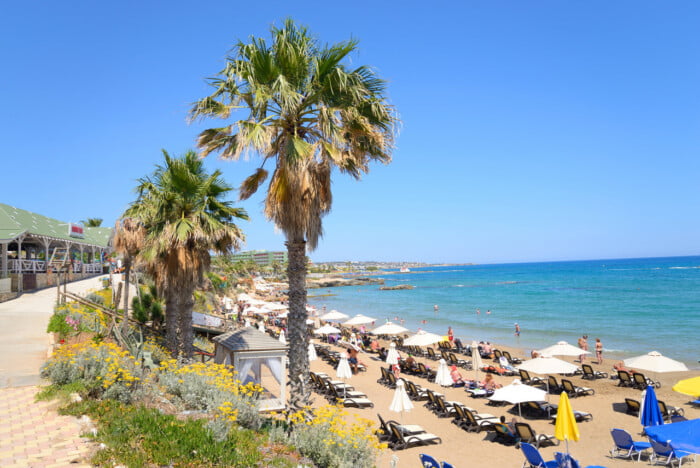Rogdia and Achlada in Crete
Rogdia and Achlada are 2 villages on the hills 20 km west of the city of Heraklion on the north coast of Crete. An interesting day trip from Heraklion, Amoudara or Agia Pelagia is a visit to Rogdia, with its remarkable views, the nearby Monastery of Savathiana, and then onward to Achlada, a once lively village, now almost abandoned by its population.
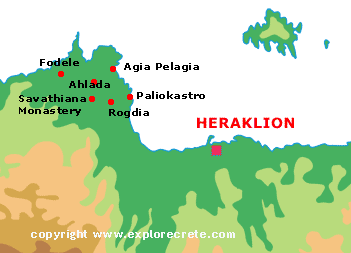
From Heraklion, it is a short journey on the big National road before we join the scenic “old road” heading west, toward Rethymnon, following the signs for Gazi and Amoudara. Very soon, we have passed the beaches at Amoudara on our right, with the entrance to the Almiros Gorge, an attractive destination for hikers, on our left.
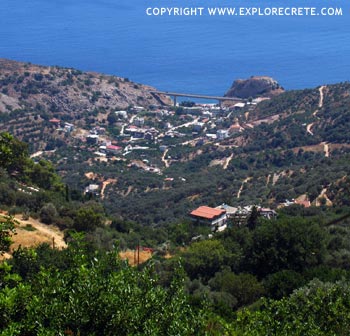
From here we can look down on Panagia Bay with its smart residential development and back towards Heraklio, as we climb on a good road with, as you would expect, lots of bends, following signs pointing, to our left, the way to Rogdia. The view becomes superb as we go up; facing a sparkling sea we can look down on all of Heraklio, this busy, congested city looking peaceful, the white of its buildings spreading away from the harbour and beginning to blend into the fields far beyond its walls. The mountains behind Heraklion can be seen from here, and Youchtas (pronounced with a soft ‘ch’ like the Scottish ‘loch’) is particularly impressive, resembling more than ever the head of the god Zeus looking up at the heavens, as the myth says.
Along this road we can see another bay, Paliokastro ( photo -> ), which has a beach and shops, and also an imposing Venetian fort, almost a castle, facing the sea, an obstacle to the pirates who terrorised these shores during the middle-ages. Plans to begin restoration on this important landmark are underway.
Rogdia
Entering Rogdia, or Rodia (it has two spellings, even in Greek, a situation that leads to confusion), we are in search of the Kalergis Villa, one of several structures in this area which date from the Venetian period between 1204 and 1669. Before describing a relic from the past, however, we should say something about Rogdia today. It is, after all, a living, working village, and close enough to Heraklio to be a fairly major attraction.
Those who want to enjoy some “time out from the city will find it here, especially at night, when the moonlit skies and nighttime views of the city offer an idyllic taste of small-town simplicity. Tavernas punctuate the front of the village without crowding out houses and shops, each seeming to offer a different view. Very easy to walk around its streets and squares, Rogdia must be considered an essential stopping-place for anyone staying in the vicinity of Heraklio or the resorts of Agia Pelagia and Fodele Beach.
Asking at the first kafenio, or coffee house, we discover that the Kalergis Villa is almost next-door, and a man from the café accompanies us to inspect the site. He expresses dismay that much needed renovation work has not been completed, as this would allow the village to show part of its heritage with pride.
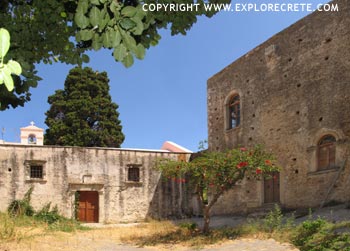
Fortunately, there are many features still intact from this very imposing old mansion-house in Rogdia. They must have been very wealthy, the Kallegis family of Byzantine origin, who had this house built. Alongside it stands a church dating from the same period, although we do now the exact origins of the church. It would send a very clear message to the villages around that here was where the power resided. Now, it is a home for pigeons, which nest in many small alcoves all around the house. I was sure Yannis was joking when he tells me, but it is true. The people of Crete liked pigeon meat so much that they were glad to share their finest houses with these creatures, fattening them up to be ready for the feast. We can’t look inside the villa, which has been fitted with new doors and window frames, but it’s interesting to see the adjacent church, now, before the restoration, and various out buildings, including the ruins of an old ‘fabrica’, an olive oil factory, behind this important villa.
The old church of Panagia of Rogdia sits beside a newer chapel with a date of 1809 inscribed above the door. We can see an ecclesiastical arched doorway, and the remnants of a church contemporary to the villa, leading to a courtyard, in which many traces of the past remain. With luck and determination, restoration will give this place new life. There is a shady courtyard behind the church where children play, and it will hopefully become part of a very attractive public space. Somewhere the people of Rogdia can feel proud to show.
We head through the small but vibrant village of Rogdia toward its very different neighbouring village, Achlada.
Achlada
A drive along Rogdia’s main street, past the ‘plateia’ or village square, and you see the sign pointing to Achlada, our destination, 7km away. The winding, un-surfaced road follows a river bed, along whose banks have sprung farm buildings and a few houses, built haphazardly, where the concept of planning permission does not seem to be a priority. Pastel-coloured beehives too, are visible among the olives and plane-trees that cover this landscape. Sheep and goats shelter in the shade of larger trees, and a midday air of stillness is disturbed only by the sound of our car. There is a turning on the right to Agia Pelagia (5km from here) at about 3km. It is a dirt road, but a good one, as these things go, and the ride is bumpy but pleasant enough. The last 1 km before Achlada, and the road becomes asphalt.
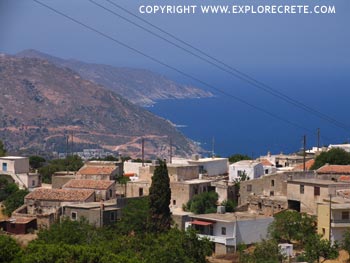
Ahlada village is the close to Agia Pelagia, and its population has almost entirely deserted this village to live and work in that coastal resort. Achlada stands silent, although not without signs of life. There is the surprising sight of a kindergarten beside the well kept, and impressively sized, church. However, those villagers we see are elderly, and the houses are almost all empty now. I feel some sadness in walking around, knowing that progress, economic necessity perhaps, has induced the young to abandon such a place. Views down to the bay of Fodele and the coast, so close to Agia Pelagia, the dramatic but sheltered position of the village, and the good land around us, are all indications that this was once a fine place to live and raise families.
Times change. The relocation of the population has meant that houses here are in various stages of neglect, many starting to fall in on themselves, others wanting only minimal attention, having been left during the last decade or so.
We understood that there still existed one kafenio, but this too has closed. Walking in the narrow streets, the impression of being in a ghost town persists. A picturesque ghost town, but a place where life has all but departed, nonetheless. In many villages, ruined houses are used for animals or as storage space. Not here. An elderly woman speaks to Yannis, and they chat for a while as I scout among the empty shops, peering through shuttered windows and gaps in boarded-up doors. A rusted bed lies beside a cupboard behind one former shop, the dusty wooden radiogram, complete with broken records, sitting on top. The far end of the village seems to be the most dilapidated, about to tumble into the valley beyond.
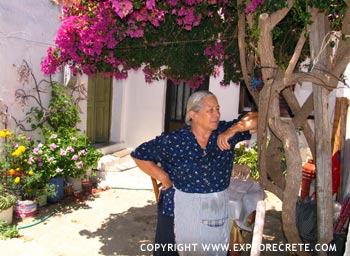
On re-joining Yannis, we are invited by the lady, Kiria (Mrs) Maria, to sit with her beside the beautiful bougainvillea tree that adds life and colour to her garden. Maria is a woman whose kindness is written in her features. She offers us cold water and tasty cookies and she answers willingly our questions about the village of Ahlada.
Before 1965 there was almost nothing in Agia Pelagia, which was a small port from where they transferred wood and coal to Heraklion. In 1965, a man appeared and started buying land from the locals for 5000 drachmas (approximately 17 EUR) for 1000 square meters (or 1 strema, the common way of measuring land in Greece). Soon another buyer showed up and he offered double the price. Tourism had just started in Greece and those two men were among the first to see the potential in this area. Soon after that, the Capsis Beach Resort was built on the Souda peninsula of Agia Pelagia.
Mrs Maria and her husband had a small taverna on the beach, where the builders used to eat. She had sold her land cheap, but they made good business with the many builders working on the huge hotel complex. Mrs Maria misses those times, when the people in her taverna were not her clients, as she says, but her good friends. This tavern has been renovated many times since then, but it is still in business today, now owned by Mrs Maria’s two sons.
This story must be a common one for the people of Achlada. Tourism turned the former farmers and shepherds into restaurant and hotel owners, who abandoned their village and moved to the beach of Agia Pelagia. We wonder what the future holds for the small community who still inhabit Achlada. Time will tell…
© explorecrete.com All Rights Reserved. Reproduction or copying without permission is prohibited.

